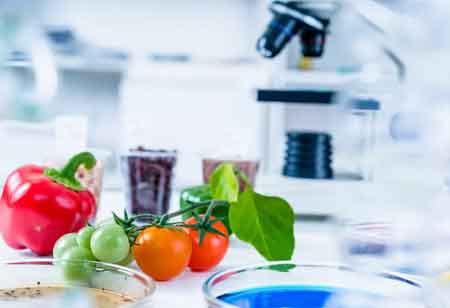THANK YOU FOR SUBSCRIBING
Be first to read the latest tech news, Industry Leader's Insights, and CIO interviews of medium and large enterprises exclusively from Food and Beverage Tech Review
The Influence of Technology on Food Safety Audit Efficiency
Technology is transforming food safety audits by increasing efficiency, accuracy, and transparency. It enables proactive risk management and enhances consumer trust in food quality and safety.

By
Food and Beverages Tech Review | Tuesday, November 12, 2024
Stay ahead of the industry with exclusive feature stories on the top companies, expert insights and the latest news delivered straight to your inbox. Subscribe today.
Technology is transforming food safety audits by increasing efficiency, accuracy, and transparency. It enables proactive risk management and enhances consumer trust in food quality and safety.
FREMONT CA: Technology is reshaping food safety audits, making them faster, more accurate, and more reliable. With innovations like digital recordkeeping, blockchain, AI, and real-time data analytics, food safety auditors can track compliance, identify risks, and streamline processes across the supply chain. These tools enable faster, data-driven decision-making and reduce human error, essential in maintaining high food safety standards. By integrating technology, organisations enhance audits' transparency and efficiency and build greater consumer trust, ensuring safer food production and handling practices in an increasingly complex global food system.
The Role of Technology in Modern Food Safety Audits
Enhancing Efficiency Through Digital Solutions
Digital tools and platforms streamline the audit process, allowing for more efficient and comprehensive inspections. Mobile applications, for instance, enable auditors to digitally document observations, capture images, and generate reports directly on-site. This eliminates the need for manual note-taking and data entry, speeding up the audit process and reducing the likelihood of errors.
Additionally, cloud-based solutions facilitate real-time data sharing and communication between audit teams and stakeholders. Auditors can instantly upload findings, share information, and receive feedback, enabling rapid decision-making and corrective action when necessary. These digital solutions make food safety audits more efficient, allowing companies to address compliance issues and improve overall safety practices quickly.
Leveraging Data Analytics for Enhanced Insights
Data analytics has become integral to food safety audits, offering valuable insights into trends and patterns related to food safety. By analysing large datasets collected during audits, advanced analytics tools can identify recurring issues, potential risks, and areas that require improvement. This data-driven approach allows auditors to prioritise actions, focus on critical control points, and allocate resources effectively to high-risk areas.
Predictive analytics, for example, can use historical data to forecast potential food safety threats, enabling proactive measures to prevent incidents. This method increases the accuracy of food safety audits and enhances compliance and safety throughout the food supply chain.
Improving Traceability Through Blockchain Technology
Blockchain technology is anticipated to transform food safety audits. With its decentralised and immutable ledger structure, it will ensure transparency and security across the entire food supply chain. Each transaction and process will be permanently recorded, providing an unalterable audit trail that allows food products to be traced from farm to table.
In the event of a food safety incident, blockchain technology enables rapid identification of contamination sources, minimising impact and allowing for targeted recalls. By enhancing traceability, blockchain technology improves the accuracy of food safety audits and builds consumer trust in the quality and safety of food products.
Automating Compliance with IoT and Sensor Technology
The Internet of Things (IoT) and sensor technology have introduced real-time monitoring capabilities that support compliance in food safety audits. IoT devices can continuously track vital environmental factors such as temperature, humidity, and cleanliness in food production and storage facilities. These sensors send real-time data to centralised systems, automatically alerting stakeholders if safety standards are breached.
Automated monitoring systems maintain food safety conditions without requiring frequent manual inspections. For instance, temperature sensors in cold storage units can trigger alerts if temperatures rise above safe levels, helping to prevent spoilage and contamination. This automated approach enhances the accuracy and reliability of food safety audits by ensuring constant compliance monitoring.
Advancing Training and Awareness Through Virtual Reality
Training and awareness are essential for an effective food safety management system, and virtual reality (VR) technology offers an innovative approach to training food safety inspectors and staff. VR simulations recreate real-world scenarios, allowing trainees to safely practice identifying hazards, performing inspections, and implementing corrective actions.
This immersive training method helps auditors build the skills to handle various food safety challenges confidently. VR training can also be extended to educate employees and food handlers, fostering a workplace culture focused on safety and hygiene.
Improving Documentation and Reporting with Digital Solutions
Accurate documentation and reporting are critical components of a food safety audit. Traditional paper-based methods can be time-consuming, error-prone, and vulnerable to record loss. Digital solutions simplify these processes, ensuring accuracy, consistency, and easy retrieval of audit records.
Audit management software allows auditors to quickly create digital checklists, log observations, and compile detailed reports. Securely storing and accessing these digital records ensures transparency and accountability in the audit process. By enhancing documentation and reporting, digital solutions contribute to food safety audits' overall quality and reliability.
By embracing these advancements, food producers and regulators can build greater consumer trust and ensure safer food handling and production practices in a complex global market. As technology continues to advance, the future of food safety audits promises even greater protection for consumers and further assurance of food quality and safety worldwide.
I agree We use cookies on this website to enhance your user experience. By clicking any link on this page you are giving your consent for us to set cookies. More info







